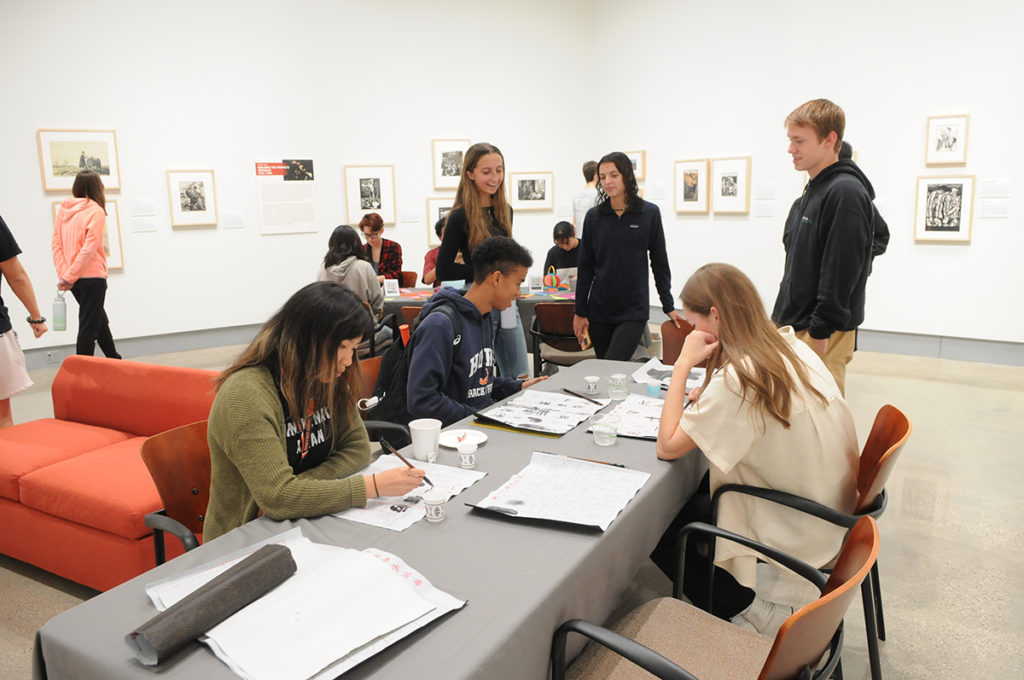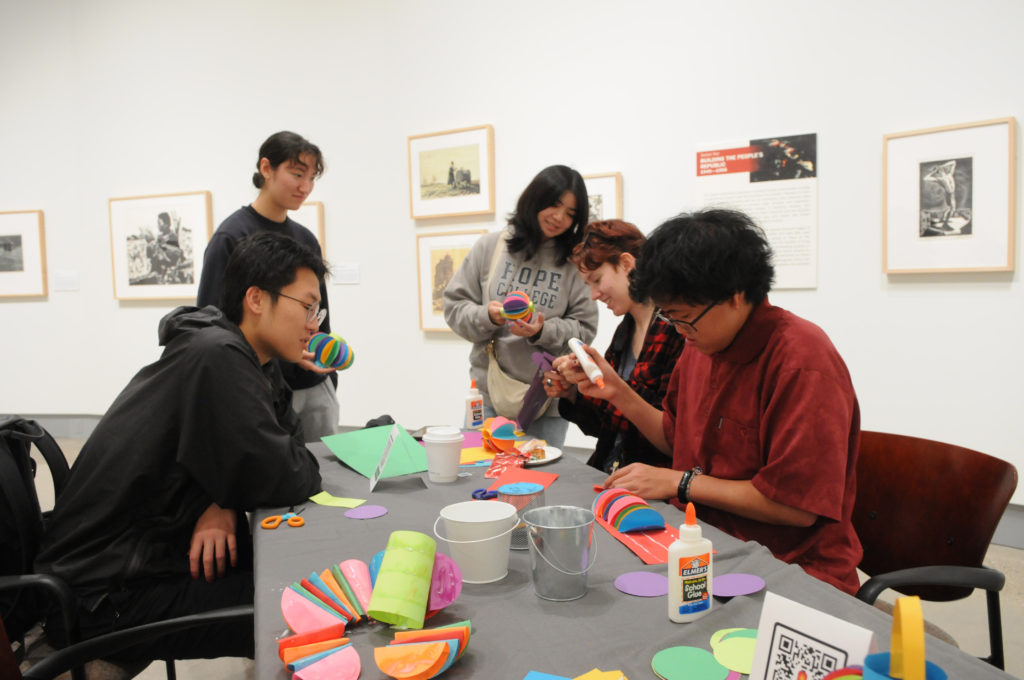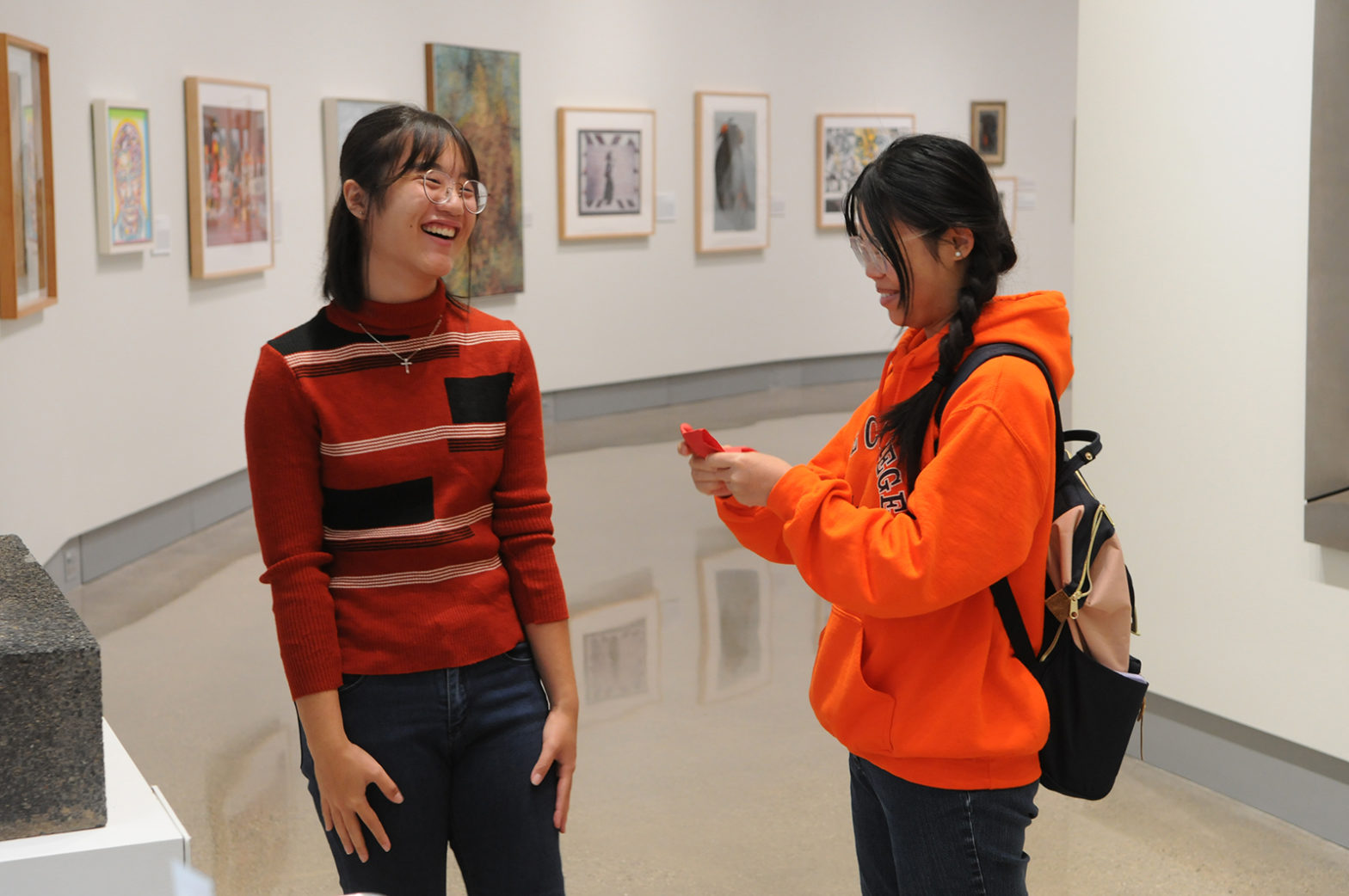Organized by the Asian Student Union in collaboration with the Kruizenga Art Museum, the campus commemoration of the historic Mid-Autumn Festival linked programs and people in celebrating the diverse traditions represented by the members of the Hope community of Asian heritage.
As a metaphor for connection, the moon was an apt symbol during the Mid-Autumn Festival held at the college’s Kruizenga Art Museum on Tuesday, Sept. 26.
Organized by the Asian Student Union in collaboration with the museum, the campus commemoration of the historic festival linked programs and people in celebrating the diverse traditions represented by the members of the Hope community of Asian heritage. A mix of students, faculty and staff attended the event, which featured a musical performance and poetry readings, hors d’oeuvres from a variety of Asian cultures, and the opportunity to craft paper lanterns and practice calligraphy — all amid the museum’s two gallery spaces and major fall exhibition, “A New Art for a New China: Modern Chinese Prints from the Ihrman Collection.”
When the Kruizenga Art Museum asked the students of the Asian Student Union if they were interested in partnering in some way during the exhibition “A New Art for a New China: Modern Chinese Prints from the Ihrman Collection,” they jumped at the chance. “A very big part of our work as the Asian Student Union is dismantling the myths that Asian culture and cultures are monolithic… For the art museum, as a college department, to reach out to a student organization I think is an incredible way to foster that sort of engagement in the community.”
—Carole Chee, Hope senior and ASU president
Hope senior Carole Chee, who is president of the Asian Student Union (ASU), noted that a version of the Mid-Autumn Festival is celebrated in multiple East- and Southeast-Asian cultures, including China, Japan, Korea and Vietnam, each with its own traditions.
“It’s just a very big cultural and also a community event in a lot of cultures,” she said. “You can kind of think of it like Thanksgiving, where it’s a time for family to come together and celebrate.”

The Chinese version of the festival, sometimes called the Moon Festival or the Mooncake Festival, dates back some 3,000 years, and celebrates harvest time when the moon is full (the Hope event was a few days early — the actual festival was on Sept. 29 this year). Lanterns are displayed as symbolic beacons to light a path to good fortune, and mooncake pastries are a staple.
Charles Mason, who is the director and Margaret Feldmann Kruizenga Curator of the Kruizenga Art Museum, shared the concept of the moon as a way of connecting people when he opened the evening’s performances with a reading — in both Chinese and English — of the poem “Quiet Night Thought,” by Tang dynasty poet Li Bai (701–762), which Mason explained is often associated with the festival:
Before my bed lies a pool of moonlight
I could imagine that it’s frost on the ground
I look up and see the bright shining moon
Bowing my head I am thinking of home.
A specialist in Asian art, Mason was introduced to the poem while pursuing his bachelor’s degree in Chinese language and literature at Cambridge University in England. Far from his native United States, he was feeling homesick when a friend encouraged him to find comfort in the poem’s imagery: that he could look up and see the moon at the same time that his family was seeing it, and perhaps feel the distance less.
Following Mason’s reading, Dr. Dennis Feater, associate professor of social work and social work program director, read the poem “Mid-Autumn Moon,” by Li Qiao; freshman pianist Rachel Chia Yen Ning performed “Moonlight in the City”; and senior An Ha read three original poems: “Me Con – a story of motherhood,” “Ancestors” and “A Love Letter to My Mexican Sisters.”
ASU has celebrated the festival, honoring the tradition’s many expressions, for several years, but usually in a smaller venue such as the Keppel House, which is home of the Center for Diversity and Inclusion where ASU is based. When the Kruizenga Art Museum asked the students if they were interested in partnering in some way during the Aug. 26–Dec. 16 exhibition, they jumped at the chance.
“A very big part of our work as the Asian Student Union is dismantling the myths that Asian culture and cultures are monolithic. Every individual experience within those cultures and with those cultures is unique,” Chee said. “We thought it would be a fun way to continue the tradition, and maybe expand it a little bit, especially our audience and just what the event would look like, being able to share that through the art, and through the performances and discussions with attendees.”
“All of our events — I’m speaking for ASU, but I think for all the MSOs [multicultural student organizations] — are open to anybody,” she said. “Maybe you’re entering a group where you might not know a lot about its history or what it represents — just come open to learn. We will welcome you with open arms in a spirit of mutual respect and recognition that we are all humans and we’re all on this earth.”
“The college emphasizes ‘Bring hope to the world,’ and we want to bring the world to Hope… And we want our students and faculty and staff and the community and people in this area to know that they can learn about and be engaged by different things, and in a safe space, in a way that they maybe wouldn’t in their day-to-day lives.”
—Allie Lewis, visitor services coordinator, Kruizenga Art Museum
“For the art museum, as a college department, to reach out to a student organization I think is an incredible way to foster that sort of engagement in the community,” Chee said. “Allie Lewis, the museum’s visitor services coordinator, was incredible in creating that outreach, being able to spread a little visibility, and providing us more resources to make this an event that we could welcome a lot of people to.”
Serving as a resource, writ large, for the campus and Holland communities has been the museum’s mission since it opened in 2015.
“We try to connect with as many student groups as our calendar allows through the year,” Lewis said.
“For example, we are working with all but one multicultural student organizations this year, plus we’re doing things with Hope Sustainability, Hope Catholics and STEP [Students Teaching and Empowering Peers],” she said. “We have a variety of events, and they vary in scale. For our major exhibition this spring, ‘New Roots, Deep Shoots: Contemporary and Modern African Art,’ we worked with the Black Student Union and Pan African Student Association to go through what we were thinking for the exhibition, because we wanted it to represent them and we want the students to come.”

In the same way, the museum engages with academic departments.
“Our collection has 8,000 objects. And one of the reasons that it is that size is so that when a professor comes to us and wants to know how art relates to something like chemistry or art architecture or what’s happened historically, or dance, we can pull from those 8,000 objects and share art that is relevant to all of these topics. Or, we can add to our collection to meet the needs of the curriculum,” Lewis said.
“The college emphasizes ‘Bring hope to the world,’ and we want to bring the world to Hope. So, we have a broad representation of different cultures and people and styles represented within our collection. It features European-American art, but it also features African art, and we have a huge Asian art collection,” she said. “And we want our students and faculty and staff and the community and people in this area to know that they can learn about and be engaged by different things, and in a safe space, in a way that they maybe wouldn’t in their day-to-day lives.”
In the case of “A New Art for a New China: Modern Chinese Prints from the Ihrman Collection,” Hope is one of the few places in the world that people can even see the art in person.
The collection includes more than 1,500 prints donated to the Kruizenga Art Museum in 2021 by Michigan native Dr. David Ihrman, who had collected them between the late 1980s and early 2000s with his late wife, Huang Dong Ihrman. Other museums were in the running to receive the pieces, with Hope selected due to a combination of Mason’s expertise and the scale of the college’s extant Asian collection, and family ties (David Ihrman’s parents were Hope alumni: Donald ’49 and Lynne VanWeelden ’51 Ihrman).
“The Ihrman Collection is, I believe, the largest and most important collection of modern Chinese prints in the United States and perhaps the second most important collection of modern Chinese prints outside of China,” Mason said. “The other one is in England.”
In the case of “A New Art for a New China: Modern Chinese Prints from the Ihrman Collection,” Hope is one of the few places in the world that people can even see the art in person. “The Ihrman Collection is, I believe, the largest and most important collection of modern Chinese prints in the United States and perhaps the second most important collection of modern Chinese prints outside of China.”
—Charles Mason, director and Margaret Feldmann Kruizenga Curator of the Kruizenga Art Museum
###
The exhibition “A New Art for a New China: Modern Chinese Prints from the Ihrman Collection” runs through Saturday, Dec. 16. There will be a public reception on Thursday, Nov. 16, from 7 p.m. to 8 p.m.
The Kruizenga Art Museum is open Tuesdays through Saturdays from 10 a.m. to 4 p.m., and admission is free. More information is available at https://hope.edu/arts/kam/
More information about the college’s multicultural student organizations (Asian Student Union, Black Student Union, Hope Advocates for Invisible Conditions, Latino Student Organization, Men’s Enrichment Network, Pan African Student Association, PRISM and Women of Color United) is available at https://hope.edu/offices/center-diversity-inclusion/student-organizations.html


